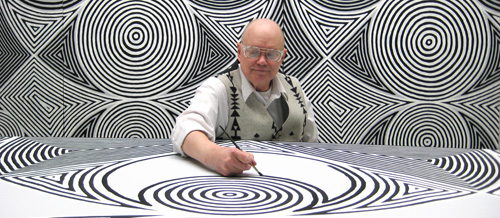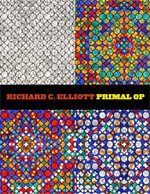"Richard C. Elliott: Works on Paper"
May 10 – July 20, 2014
Study Gallery and Print Study Center

Dick Elliott painting in his studio, 2007. Photo: Jane Orleman
Richard C. Elliott (American, 1945-2008) was a nationally recognized mixed media artist who lived and worked in Ellensburg, Washington. In May, two exhibitions unite to present a major retrospective of Elliott’s work. Organized by Director John Olbrantz, the exhibitions feature a range of prints, drawings, sculptures, reflector paintings and related ephemera from the past four decades.
Richard C. Elliott: Works on Paper
May 10 - July 20, 2014
Study Gallery and Print Study Center
During his lifetime, Elliott created a wide variety of works on paper. The Study Gallery features paintings, prints, and sculptures that were created in the 1980s when he was heavily influenced by Australian Aboriginal art and performance art. The Print Study Center includes prints from the last few years of his life, when Elliott began an almost obsessive exploration of color and pattern in his quest to connect with the primal sources of art.
Richard C. Elliott: Primal Op
May 31 - August 24, 2014
The Melvin Henderson-Rubio Gallery and the Maribeth Collins Lobby
This exhibition traces the artistic career of Elliott from his early drawings and performance pieces from the late 1970s and 1980s to the development of his safety reflector artworks from the 1990s and early 2000s that brought widespread attention and recognition to this innovative yet largely overlooked artist.
About the Artist
Born in Portland, Oregon, Elliott received his BA degree from Central Washington University in Ellensburg in art and economics. During the 1970s, he made meticulous drawings of his friends and other subjects, weaving light and form together to capture a particular moment in time. By the early 1980s, however, he no longer felt that he could express what he wanted to about light and natural structure in drawing. He began to explore primary colors and light active materials, and by 1987, decided to focus on the safety reflector as his medium of choice.
During the 1990s and early 2000s, Elliott created a broad range of work that combined safety reflectors with two-dimensional geometric designs: site specific installations, reflectors mounted onto wood and canvas, and numerous public art commissions, including the Hallie Ford Museum of Art. He even experimented with neon in his ongoing exploration of light. During the last year of his life, he turned his attention to a series of computer-generated prints utilizing thousands of different colors and geometric designs.

Borrow a Museum Flashlight
“Primal Op” represents an unusual opportunity for museum goers. In an effort to help visitors more fully appreciate what Elliott sought to share with his audiences, the museum invites viewers to activate their own fun-filled sensory experience by borrowing a museum flashlight.
Elliott's biographer Sheila Farr says, “The beam of a flashlight or a ray of sunlight jolts the image into life, turning an installation of multicolored reflectors into a walk-in kaleidoscope. Silvery as moonlight on water or explosive as fireworks: the possibilities of the medium seemed limitless to Elliott and kept him spellbound for the last three decades of his life.”
Exhibition Related Events
Conversation and Reception
Remembering Dick Elliott
Friday, May 30 at 5 p.m.
Willamette University College of Law, Paulus Lecture Hall
Free and open to the public
Family members Jane Orleman (Elliott’s widow) and Jim Elliott (brother) join biographer Sheila Farr, close friend John Hofer, Elliott’s fabricator Richard Johnson and HFMA director John Olbrantz to reflect on the artist’s life and career.
Gallery Talk
Tuesday June 3, 2014 at 12:30 p.m.
Join Hallie Ford Museum of Art Director John Olbrantz for a guided tour of the exhibition.
Free and open to the public
Special Exhibition Note: Parts of this exhibition contain stylized nudity.
Exhibition Related Publication

The exhibition is accompanied by a full-color monograph by Seattle art critic and Seattle art writer Sheila Farr. In her essay, Farr provides the first critical assessment of Elliott’s work and places him within the broader context of 20th-century art.
Richard C. Elliott: Primal Op
By Sheila Farr
© 2014
Price: $24.95
Financial support for the exhibition and book has been provided by funds from Caroline Rubio, mother of Melvin Henderson-Rubio, WU ‘74. Additional support has been provided by grants from the City of Salem’s Transient Occupancy Tax funds, and the Oregon Arts Commission.



